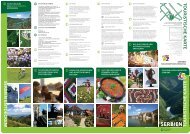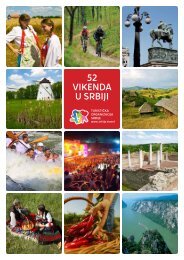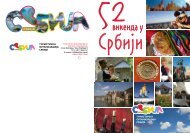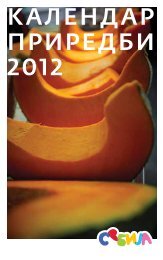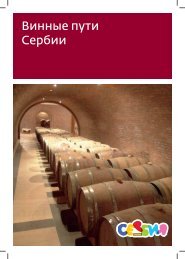Download - National Tourism Organisation of Serbia
Download - National Tourism Organisation of Serbia
Download - National Tourism Organisation of Serbia
Create successful ePaper yourself
Turn your PDF publications into a flip-book with our unique Google optimized e-Paper software.
Child and Youth<br />
Educational <strong>Tourism</strong><br />
in Rural Areas<br />
NATIONAL TOURISM<br />
ORGANISATION<br />
<strong>of</strong> SERBIA<br />
Sustainable <strong>Tourism</strong> for Rural Development<br />
a joint UN programme in <strong>Serbia</strong>
Table <strong>of</strong> contents<br />
What Is <strong>Tourism</strong>?<br />
What Is Rural <strong>Tourism</strong>?<br />
What Is Child and Youth <strong>Tourism</strong>?<br />
Relationship between <strong>Tourism</strong> and Education<br />
The Structural Schema <strong>of</strong> Child and Youth <strong>Tourism</strong><br />
Services in Child and Youth <strong>Tourism</strong><br />
Realization <strong>of</strong> Services in Child and Youth <strong>Tourism</strong><br />
The Role <strong>of</strong> the School in Child and Youth <strong>Tourism</strong><br />
Models:<br />
- Educational Farms<br />
- Edutainment Centres<br />
- Various Rural Thematic Centres<br />
- Discovery Centres<br />
- Recreational Centres<br />
How to Establish and Develop Child and Youth <strong>Tourism</strong> Services?<br />
Tips<br />
Proposal for Labelling<br />
2<br />
3<br />
4<br />
4<br />
6<br />
8<br />
10<br />
12<br />
13<br />
14<br />
15<br />
16<br />
18<br />
19<br />
20<br />
22<br />
23
What<br />
Is <strong>Tourism</strong>?<br />
“There is no better way to learn<br />
about a new culture than to experience<br />
it first-hand. <strong>Tourism</strong> <strong>of</strong>fers<br />
a wonderful connecting thread between<br />
visitor and host community.<br />
It promotes dialogue and interaction.<br />
Such a contact between people<br />
<strong>of</strong> different backgrounds is the very<br />
foundation for tolerance. In a world<br />
2<br />
struggling for peaceful coexistence,<br />
tourism can build bridges and contribute<br />
to peace,”<br />
Ban Ki-Moon, Secretary-General <strong>of</strong><br />
the United Nations, in his letter addressed<br />
to the World <strong>Tourism</strong> Organization<br />
on World <strong>Tourism</strong> Day,<br />
September 27th 2011.
What Is Rural <strong>Tourism</strong>?<br />
Rural tourism (Lat. rus, ruris – the<br />
country, countryside) enables us to<br />
leave the urban environment and<br />
enjoy natural beauty, agricultural diversity,<br />
tranquillity and the cultural<br />
richness <strong>of</strong> small towns; to find relief<br />
from the pressures <strong>of</strong> an urban<br />
lifestyle, in activities ranging from<br />
hiking, mountaineering and adventure<br />
tours, through experiencing the<br />
local cuisine, language and customs,<br />
to horseback riding, fishing and birdwatching.<br />
Rural tourism includes different<br />
types <strong>of</strong> in-country tourism, as well<br />
as other tourism models realized in<br />
rural areas, such as sports or medical<br />
tourism, educational travelling,<br />
artistic and cultural tourism, ethnic<br />
and eco-tourism. Rural tourism<br />
<strong>of</strong>fers a mixture <strong>of</strong> activity and passivity,<br />
fun and education, modernity<br />
and tradition.<br />
One essential aspect <strong>of</strong> rural tourism<br />
is the tourists’ contact with a<br />
local populace <strong>of</strong>fering kindness,<br />
hospitality and warmth, making the<br />
tourists eager to return.<br />
3
What Is Child and Youth <strong>Tourism</strong>?<br />
Although the category <strong>of</strong> child and<br />
youth tourism is not strictly defined<br />
in <strong>Serbia</strong> as a separate tourism category,<br />
and bearing in mind that the<br />
age ranges <strong>of</strong> children and youth<br />
vary considerably between different<br />
national and international institutions,<br />
child and youth tourism may<br />
be broadly defined as tourism that<br />
addresses the needs <strong>of</strong> a heterogeneous<br />
beneficiary group aged between<br />
three and thirty years <strong>of</strong> age.<br />
Children and youth in this age range<br />
are highly valuable visitors who,<br />
Relationship between<br />
<strong>Tourism</strong> and Education<br />
within the parameters <strong>of</strong> what tourism<br />
can <strong>of</strong>fer, expand their knowledge,<br />
develop personal skills (especially<br />
social and cultural ones), gain<br />
and broaden their experience, make<br />
contacts with their peers and make<br />
a substantial economic contribution<br />
to the places they visit.<br />
<strong>Tourism</strong> for children and youth represents<br />
a segment <strong>of</strong> rural tourism,<br />
or, more precisely, one <strong>of</strong> the elements<br />
<strong>of</strong> the total package <strong>of</strong> rural<br />
tourism.<br />
Every tourist trip represents an act<br />
<strong>of</strong> gaining knowledge. By travelling,<br />
people familiarize themselves with<br />
new landscapes, populations, languages,<br />
cultures and customs.<br />
However, the didactic purpose <strong>of</strong><br />
tourism may be even more pronounced,<br />
thus promoting education<br />
and improving the quality <strong>of</strong> education<br />
for children and youth.<br />
<strong>Tourism</strong> aimed at gaining concrete<br />
knowledge through designed programmes<br />
may be called educational<br />
tourism. It represents a highly important<br />
aspect <strong>of</strong> child and youth<br />
tourism. The models that we propose<br />
further on in this document<br />
belong to this particular branch <strong>of</strong><br />
tourism.<br />
4
The Structural Schema<br />
<strong>of</strong> Child and Youth <strong>Tourism</strong><br />
In accordance with the given definition <strong>of</strong> the term child and youth tourism,<br />
a structural schema <strong>of</strong> the system for this branch <strong>of</strong> tourism could be:<br />
Child<br />
<strong>Tourism</strong><br />
0 - 6 years old<br />
7 - 15 years old<br />
School<br />
<strong>Tourism</strong><br />
Youth<br />
<strong>Tourism</strong><br />
15 - 19 years old<br />
20 - 24 years old<br />
25 - 30 years old<br />
Educational<br />
<strong>Tourism</strong><br />
The schema clearly shows that<br />
school and educational tourism<br />
are the sub-categories <strong>of</strong> child<br />
and youth tourism which can<br />
overlap, but not necessarily, since<br />
6<br />
educational also process happens<br />
out <strong>of</strong> the school system. On the<br />
other hand, educational tourism<br />
can cover different ages.
Services in<br />
Child and Youth <strong>Tourism</strong><br />
The services required in child and<br />
youth tourism are those that provide<br />
children and youth with the<br />
opportunity to investigate and acquaint<br />
themselves with cultural and<br />
historical contents and facilities, to<br />
gain and broaden their knowledge,<br />
improve their health, perfect their<br />
skills and acquire new ones, participate<br />
in events that give them a<br />
sense <strong>of</strong> self-fulfilment, get to know<br />
new places, customs and natural environments,<br />
establish contacts, as<br />
well as to develop network <strong>of</strong> collaborators<br />
and friends.<br />
Simultaneously, child and youth<br />
tourism services contribute to a<br />
sense <strong>of</strong> increased understanding<br />
and cooperation among youth from<br />
different surroundings and states, as<br />
much as they promote tourist, educational,<br />
cultural, natural and other<br />
resources <strong>of</strong> different communities<br />
and states.<br />
Services in child and youth tourism<br />
have their material and non-material<br />
characteristics, both <strong>of</strong> them<br />
equally important for their successful<br />
development.<br />
8
Characteristics <strong>of</strong> Services in Child and Youth <strong>Tourism</strong><br />
Material<br />
Characteristics<br />
Quality<br />
Non-material<br />
Characteristics<br />
- Form/model<br />
- Formal organizers<br />
- Programme concept and aims<br />
- Service providers – contents/price ratio<br />
- Performance standards<br />
- Realization effects<br />
- Safety<br />
- Environment<br />
- Respect<br />
- Ability<br />
- Hospitality<br />
- Cordiality<br />
- Convenience<br />
- Cooperation<br />
9
Realization <strong>of</strong> Services<br />
in Child and Youth <strong>Tourism</strong><br />
In accordance with an approach oriented towards the age categories <strong>of</strong><br />
beneficiaries, tourist services could adopt two basic approaches:<br />
Realization <strong>of</strong> services as a part<br />
<strong>of</strong> a diverse tourist package, outside<br />
the formal education system<br />
Should address the needs, interests<br />
and wishes <strong>of</strong> children and youth in<br />
all age groups and includes different<br />
types <strong>of</strong> services.<br />
10
Realization <strong>of</strong> services within<br />
the formal education system<br />
(preschool, primary and secondary<br />
education)<br />
Directly connected with the educational<br />
aims <strong>of</strong> the school curriculum,<br />
it contributes to the effectiveness<br />
<strong>of</strong> education itself, as well as to the<br />
overall development <strong>of</strong> children’s<br />
personalities.<br />
11
The Role <strong>of</strong> the School<br />
in Child and Youth <strong>Tourism</strong><br />
Schools can and should have a prominent<br />
place in the development <strong>of</strong><br />
child and youth tourism, especially<br />
in improving the quality <strong>of</strong> the curriculum<br />
for school trips, residential<br />
outdoor schools and recreational<br />
education.<br />
The involvement <strong>of</strong> village schools<br />
in the development <strong>of</strong> this type <strong>of</strong><br />
tourism in rural areas is vital, since<br />
they could utilize their facilities,<br />
which are <strong>of</strong>ten unused, to facilitate<br />
tourism for children and youth<br />
(for accommodation, creative workshops<br />
etc.). Teachers could create<br />
educational programmes to enable<br />
children and youth to acquire knowledge<br />
through workshops, teaching<br />
in nature, practical work etc. - all<br />
with help from the local populace.<br />
12
Models<br />
Child and youth tourism is likely to<br />
develop through different concepts<br />
and models. Each concepts can be<br />
realized through different models<br />
developed in accordance with the<br />
characteristics and specialities <strong>of</strong><br />
each environment and local community.<br />
The models are developed<br />
by service providers, and by other<br />
exponents and implementers <strong>of</strong><br />
child and youth tourism (schools,<br />
local government, tourist organizations,<br />
households in tourism etc.) in<br />
accordance with the characteristics<br />
<strong>of</strong> the specific environment.<br />
The range and scope <strong>of</strong> the models<br />
depend on their potential, as well<br />
as on the abilities <strong>of</strong> the implementers<br />
themselves. Further on in this<br />
document, you can find some <strong>of</strong> the<br />
models that could be developed in<br />
the rural parts <strong>of</strong> <strong>Serbia</strong>. They represent<br />
basic framework concepts for<br />
the development <strong>of</strong> child and youth<br />
tourism, and each <strong>of</strong> them includes<br />
an educational component. It is important<br />
that within these tourism<br />
models, children and youth acquire<br />
different skills, <strong>of</strong>ten unaware <strong>of</strong><br />
the fact that they have been learning<br />
since this education happens<br />
through fun activities.<br />
Each <strong>of</strong> the models listed may include<br />
the activities itemized here,<br />
but this is not essential; the content<br />
<strong>of</strong> models is sure to vary depending<br />
on what the destination has to <strong>of</strong>fer.<br />
Furthermore, models may be combined<br />
in order to create a destination<br />
which <strong>of</strong>fers a multitude <strong>of</strong> contents<br />
and activities. Each model can<br />
<strong>of</strong>fer learning in line with the <strong>of</strong>ficial<br />
school curriculum, combined with<br />
the acquisition <strong>of</strong> skills and experiences<br />
unrelated to the curriculum.<br />
13
Educational Farms<br />
14<br />
This is a model for pre-school<br />
and primary school children and<br />
their families.<br />
Children can learn about country<br />
life and still have fun.<br />
They can learn about the life on<br />
a farm through farming activities<br />
(feeding animals, caring for<br />
plants and crops, making dairy<br />
products, following the process<br />
<strong>of</strong> making bread from grain<br />
to flour to the baked product,<br />
watching bees, extracting honey<br />
etc.).<br />
They can also expand their<br />
knowledge <strong>of</strong> the countryside<br />
and country life on nearby farms,<br />
markets, in the workshop <strong>of</strong><br />
country craftsmen where they<br />
can learn how to weave, make<br />
shoes or pottery.<br />
On these farms, children would<br />
be fed domestic produce only.
Edutainment Centres<br />
This model is aimed at preschool,<br />
primary and secondary school<br />
children and their families.<br />
It resembles the educational<br />
farm, but <strong>of</strong>fers a somewhat wider<br />
range <strong>of</strong> activities that are not<br />
necessarily related to acquiring<br />
country life skills.<br />
In these centres children learn<br />
through practical work. For example:<br />
the knowledge <strong>of</strong> the<br />
world surrounding us is applied<br />
in garden cultivation, growing<br />
fruit and vegetables; the knowledge<br />
<strong>of</strong> mathematics and physics<br />
is utilized in constructing a minicabin;<br />
linguistic knowledge is improved<br />
through researching local<br />
dialects and place names; art<br />
knowledge is utilized by preparing<br />
exhibitions, weaving or making<br />
ceramic objects, while music<br />
knowledge is developed by studying<br />
traditional instruments.<br />
15
Various Rural Thematic Centres<br />
This is for children and youth <strong>of</strong> all ages, but especially for youth.<br />
The possibilities include:<br />
Rural art centres<br />
16<br />
Love <strong>of</strong> art, and the talents that<br />
children and youth possess, are<br />
nurtured;<br />
Children may paint, sculpt, make<br />
useful objects and perfect their<br />
skills with the help <strong>of</strong> local artists;<br />
Art colonies may be organized in<br />
these centres;<br />
All the activities are organized<br />
close to nature.<br />
Rural recycling centres<br />
Awareness <strong>of</strong> the importance <strong>of</strong><br />
safeguarding the environment is<br />
raised through recycling;<br />
Art objects may be created out<br />
<strong>of</strong> objects meant for recycling,<br />
thereby nurturing creativity and<br />
ecological awareness.<br />
Rural ecology centres<br />
Awareness <strong>of</strong> the importance <strong>of</strong><br />
safeguarding nature, the importance<br />
<strong>of</strong> using renewable energy<br />
resources, decreasing pollution,<br />
etc. is raised;<br />
All the activities are naturefriendly,<br />
be it the making <strong>of</strong> concoctions<br />
and balms out <strong>of</strong> natural<br />
ingredients, preserving drinking<br />
water, making small wind generators,<br />
or demonstrating the<br />
potential <strong>of</strong> solar panels.<br />
Rural adventure centres<br />
Children and youth are taught,<br />
through adventure, the skills <strong>of</strong><br />
surviving in nature and natural<br />
laws;<br />
Activities in these centres promote<br />
both intellectual and corporal<br />
development, since most<br />
<strong>of</strong> them encourage physical activity,<br />
and they are integrated<br />
with nature and require natural<br />
materials (wood, stone etc.);<br />
Activities range from mountaineering,<br />
orienteering or learning<br />
to make fire to exploration <strong>of</strong> flora<br />
and fauna in order to survive<br />
in nature, or search for objects<br />
through solving riddles.
Discovery Centres<br />
These are for children and youth<br />
<strong>of</strong> all ages.<br />
They provide children and youth<br />
with opportunities to explore<br />
and learn through programmes<br />
with theoretical and practical<br />
components.<br />
Discovery Centres will have educational,<br />
as well as entertainment<br />
activities.<br />
Centres may consist <strong>of</strong> one or<br />
more buildings or facilities, and<br />
be equipped with the technical<br />
means necessary to implement<br />
the intended activities.<br />
They may organize activities related<br />
to archaeology or conservation,<br />
natural expeditions, historical<br />
or cultural explorations,<br />
science explorations and experiments.<br />
O 2<br />
18
Recreational Centres<br />
These are intended for children<br />
and youth <strong>of</strong> all ages, especially<br />
those aged 7 to 15.<br />
They may <strong>of</strong>fer various sports<br />
and recreation activities, depending<br />
on the resources <strong>of</strong>fered by<br />
the local environment.<br />
They could also <strong>of</strong>fer different<br />
programmes for recovery, climate<br />
related treatments, rest and<br />
recreation.<br />
The possibilities include:<br />
winter sports centre<br />
water sports centre<br />
forest adventure centre for<br />
extreme sports<br />
These centres should include<br />
both active and passive zones,<br />
since they also need to <strong>of</strong>fer possibilities<br />
for rest, entertainment,<br />
learning and fun.<br />
19
How to Establish and Develop Child<br />
and Youth <strong>Tourism</strong> Services ?<br />
Preparation for the establishment and development <strong>of</strong> services for child<br />
and youth tourism may be divided into 3 phases:<br />
1.<br />
If you are interested in organizing<br />
child and youth tourism, it is necessary,<br />
as the first step, to consider the<br />
idea you seek to realize.<br />
Then you need to analyze the possibilities<br />
for its realization, that is, to<br />
ascertain whether the need for such<br />
a service exists and the potentials,<br />
resources and facilities available for<br />
its realization. It is very important<br />
when processing the idea, to analyse<br />
its economic and financial impact on<br />
the local environment <strong>of</strong> both service<br />
provider and the potential beneficiaries.<br />
During this analysis, you<br />
need to establish whether similar<br />
services exist in your surroundings,<br />
and see their impact.<br />
20<br />
2.<br />
In this phase prepare an outline <strong>of</strong><br />
your proposed programme or project<br />
taking two aspects into account:<br />
the needs <strong>of</strong> the potential beneficiaries<br />
you seek to attract and the potential<br />
<strong>of</strong> the local environment.<br />
If educational programmes are being<br />
organized, ensure they are harmonized<br />
with the prescribed aims<br />
and tasks <strong>of</strong> the concepts and models<br />
defined for particular age groups.<br />
If programmes for youth are<br />
envisaged, which are not directly<br />
related to the realization <strong>of</strong> a school<br />
curriculum, ensure the aims and<br />
contents are defined in line with<br />
those agreed for all the services in<br />
this rural tourism category.<br />
Proposed programmes must fulfil<br />
all the established characteristics <strong>of</strong><br />
child and youth tourism services and<br />
be harmonized with all the regulations<br />
and norms pertaining to the realization<br />
<strong>of</strong> tourism services (valid regulations<br />
may be accessed through<br />
the links listed at the conclusion <strong>of</strong><br />
this document).
3.<br />
If you successfully realize all the<br />
steps in the first two phases, you<br />
have met all the preconditions to<br />
develop an organizational structure<br />
for the service and to initiate its implementation.<br />
Simultaneously, you need to develop<br />
all the promotional activities.<br />
In order to secure and maintain the<br />
quality <strong>of</strong> service provision, it is necessary<br />
to constantly monitor and<br />
evaluate the service and thus detect<br />
the weaknesses and problems,<br />
as well as the ways <strong>of</strong> overcoming<br />
them.<br />
21
Tips<br />
Use your resources the best way<br />
possible!<br />
Use everything available to you!<br />
The very thing that may seem mundane<br />
and trivial to you, may constitute<br />
someone else’s unique experience.<br />
Furthermore, the skills and<br />
knowledge that you find common in<br />
your environment might prove to be<br />
invaluable to others.<br />
Use your resources both<br />
traditionally and originally!<br />
Combine tradition and modernity!<br />
The combination <strong>of</strong> experience and<br />
innovation always proves to be successful.<br />
Be creative!<br />
Set your imagination free! Try to be<br />
original and invent programmes that<br />
would make young tourists want to<br />
come back for more.<br />
Cooperate!<br />
When you use the potential <strong>of</strong>fered<br />
by other individuals and institutions<br />
in the neighbourhood, your <strong>of</strong>fer<br />
will become more attractive.<br />
Develop your knowledge and<br />
your service!<br />
Constant improvement <strong>of</strong> quality is<br />
the only way to success.<br />
22
Proposal for Labelling<br />
Although child and youth tourism in <strong>Serbia</strong> is not defined as a separate tourism<br />
category and no <strong>of</strong>ficial system <strong>of</strong> marking destinations, possibilities or<br />
contents exists, below is a proposal as to how it could be done. *<br />
Child and Youth <strong>Tourism</strong><br />
Exploring farm life<br />
Availability <strong>of</strong> accommodation<br />
Availability <strong>of</strong> catering<br />
Exploring traditional country life and rural<br />
cultural heritage (myths, legends, traditional<br />
games, dances and skills)<br />
Studying ecology<br />
Possibility to put up a tent<br />
Availability <strong>of</strong> creative workshops<br />
Accessibility to the persons with<br />
disability<br />
Availability <strong>of</strong> library<br />
Suitability for school groups<br />
Vicinity <strong>of</strong> natural and cultural sites (national<br />
parks, monuments etc.)<br />
Suitability for family vacation<br />
Availability <strong>of</strong> hiking and biking treks<br />
Exploring nature<br />
(landscape, environment)<br />
Availability <strong>of</strong> sport facilities<br />
Exploring flora and fauna<br />
Horseback riding<br />
*this labelling system is adopted within the<br />
Joint United Nations Programme „Sustainable<br />
<strong>Tourism</strong> for Rural Development“<br />
23
CHILD AND YOUTH EDUCATIONAL TOURISM IN RURAL AREAS<br />
Publisher<br />
<strong>National</strong> <strong>Tourism</strong> <strong>Organisation</strong> <strong>of</strong> <strong>Serbia</strong><br />
Čika Ljubina 8, Belgrade<br />
Tel: +381 11/6557-100<br />
Fax: +381 11/2626-767<br />
E-mail: <strong>of</strong>fice@serbia.travel<br />
www.serbia.travel<br />
www.facebook.com/serbia.travel<br />
Co-Publisher<br />
UNICEF <strong>Serbia</strong><br />
Svetozara Markovića 58, Belgrade<br />
Tel: +381 11/3602100<br />
Fax: +381 11/6302111<br />
Е-mail: belgrade@unicef.org<br />
www.unicef.rs, www.unicef.org/serbia<br />
Support<br />
United Nations Joint Programme ‘Sustainable <strong>Tourism</strong> for Rural Development’<br />
Bulevar Kralja Aleksandra 15, Belgrade<br />
3rd floor, <strong>of</strong>fices 320 and 321<br />
Тел: +381 11/2855217<br />
Фаx: +381 11/2855222<br />
www.un.org.rs/strd<br />
For publisher<br />
Gordana Plamenac, CEO / Managing Director<br />
Prepared by<br />
Vera Jovanović, within the United Nations Joint Programme<br />
‘Sustainable <strong>Tourism</strong> for Rural Development’<br />
Illustration<br />
Andrej Vojković<br />
Design<br />
Marijana Markoska<br />
Translation<br />
Milan Marković<br />
Pro<strong>of</strong>reading<br />
Kevin Byrne<br />
Printing<br />
KOMAZEC d.o.o, Inđija, Kralja Petra I bb<br />
Circulation<br />
1,000<br />
Support<br />
© Copyright: <strong>National</strong> <strong>Tourism</strong> <strong>Organisation</strong> <strong>of</strong> <strong>Serbia</strong><br />
24



